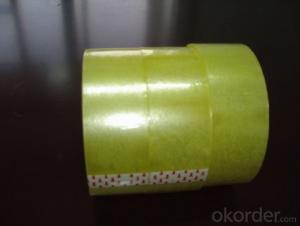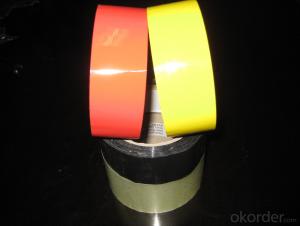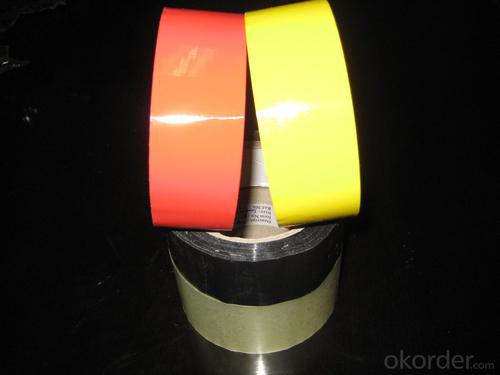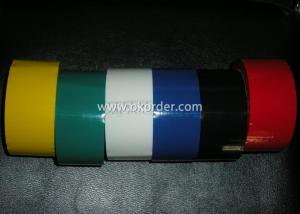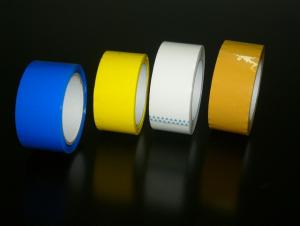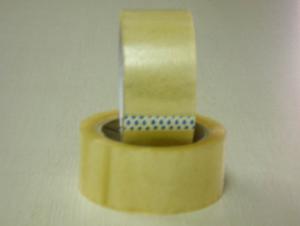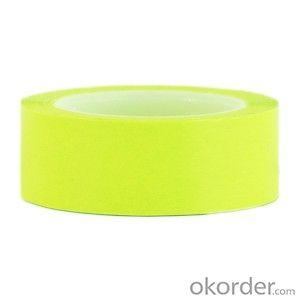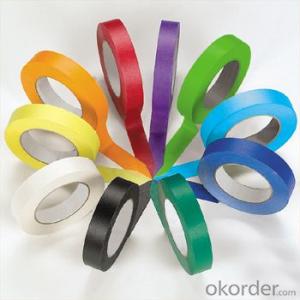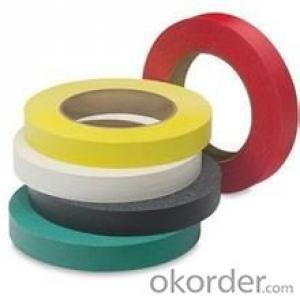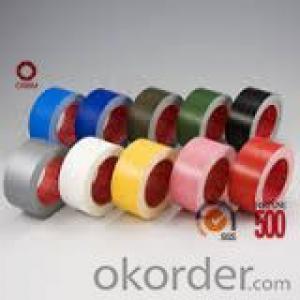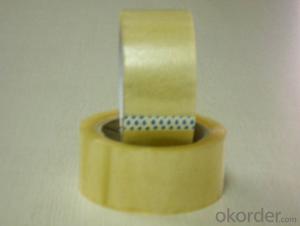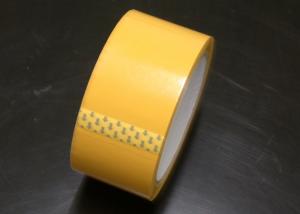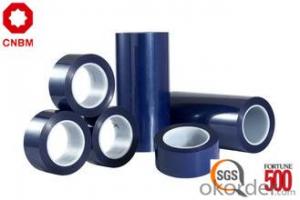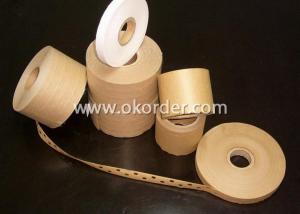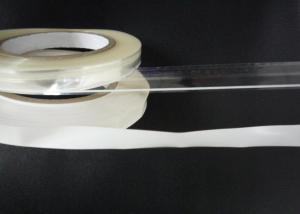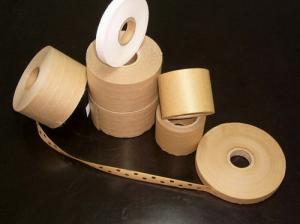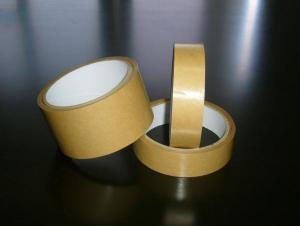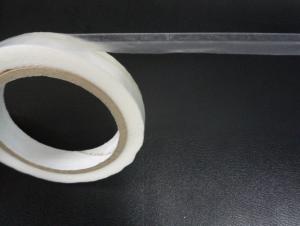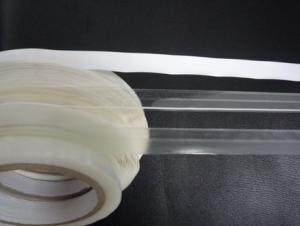Compostable Colored BOPP Packing Tape 50 Micron
- Loading Port:
- China Main Port
- Payment Terms:
- TT OR LC
- Min Order Qty:
- -
- Supply Capability:
- -
OKorder Service Pledge
OKorder Financial Service
You Might Also Like
CONSTRUCTION:
Carrier: BOPP film
Adhesive: Water based acrylic adhesive.
TYPICAL PHYSICAL PROPERTIES:
Total Thickness (adhesives + carrier): 50 ± 2 um
Initial Tack (11mm steel ball): ³ 18#
180O Peel Adhesion (to steel): ³ 0.5 kgf /25mm
Holding Power: ³ 24 hrs
Tensile Strength: ³ 30 N/cm
Elongation: ≤180%
PACKING:
Core I.D.: 3” (76mm±1)
Jumbo Roll:1280mm x 4000m
Cut Roll: As per customer’s requirements
Application:
Carton sealing & packing, Light duty packaging, bundling, holding, and other office & household use.
REMARKS:
1. The data above are typical results and subject to change without notice.
2. Tolerance: Weight and Thickness: ±10%; Width: ±3mm;
Length: Cut Roll & Log Roll ±0.3m, Jumbo Roll ±0.5%.
3. The products should be stored at room temperature and be kept away wet and/or heat source.
4. It is essential, as with all pressure-sensitive tapes, that the surface to which the tape is applied must be clean, dry, and free of grease and oil.
5. The users should take test and do trial-application on the above products before coming into application so as to witness and ensure suitability for their special purpose and technique.
- Q: How do I prevent packaging tape from tearing during removal?
- To prevent packaging tape from tearing during removal, there are a few strategies you can try: 1. Apply heat: One effective method is to use a hairdryer or heat gun to warm up the tape. The heat softens the adhesive, making it easier to peel off without tearing. Be careful not to overheat or burn the tape, though. 2. Use a cutting tool: If the tape is difficult to remove, you can use a sharp cutting tool like a utility knife or scissors to carefully cut through it. This way, you can avoid tearing the tape and remove it in smaller, more manageable sections. 3. Slow and steady approach: Take your time and be patient when removing the tape. Pull it slowly and at a low angle, applying gentle pressure to avoid tearing. If you encounter resistance, stop and try a different angle or apply a bit of heat to loosen the adhesive. 4. Seek assistance from a solvent: If the tape is particularly stubborn, you can try using a solvent like rubbing alcohol or adhesive remover. Apply a small amount to a cloth or cotton ball and gently rub it on the tape to dissolve the adhesive. Test the solvent on a small, inconspicuous area first to ensure it doesn't damage the surface. 5. Choose the right tape: Using high-quality packaging tape can also help prevent tearing during removal. Look for tapes with strong adhesion and good tensile strength. Reinforced or heavy-duty tapes tend to be more resistant to tearing. By employing these techniques and being cautious, you can successfully remove packaging tape without tearing it.
- Q: Can packaging tape be used for sealing PVC pipes?
- Using packaging tape to seal PVC pipes is not recommended. PVC pipes need a specialized sealant that can bond with the PVC material and create a tight seal to prevent water leakage. Packaging tape is not suitable for this task and may not offer a reliable and durable seal. To ensure a proper and long-lasting seal, it is advised to use sealants or plumber's tape specifically designed for PVC pipes.
- Q: Can packaging tape be used for sealing packages with delicate fabrics or clothing?
- Yes, packaging tape can be used for sealing packages with delicate fabrics or clothing. However, it is important to exercise caution and take certain precautions to protect the delicate items. Here are a few tips to ensure safe packaging: 1. Use a wide, clear packaging tape: Opt for a wide tape that allows for a larger surface area of adhesion. Clear tape is preferable as it reduces the risk of leaving any visible residue or marks on the fabric. 2. Double-layer the tape: Apply two layers of packaging tape to provide extra strength and security to the package. This will help prevent the tape from accidentally peeling off during transit. 3. Wrap the delicate items securely: Before sealing the package, make sure to wrap the delicate fabrics or clothing in a protective layer, such as tissue paper or bubble wrap. This additional layer will act as a buffer and safeguard the items from any potential damage caused by the tape. 4. Avoid excessive tension: While sealing the package, be careful not to pull too tightly on the tape. Applying excessive tension may cause the fabric to stretch or distort, potentially damaging the delicate item. 5. Consider alternative options: If the delicate item is particularly fragile or valuable, it may be worth considering alternative packaging materials, such as acid-free tissue paper or garment bags. These options provide even more protection and are specifically designed for preserving delicate fabrics and clothing. Ultimately, while packaging tape can be used for sealing packages with delicate fabrics or clothing, it is essential to handle the items with care and take appropriate measures to minimize any potential damage during the packaging process.
- Q: Is packaging tape resistant to UV rays?
- Yes, packaging tape is generally resistant to UV rays. Most packaging tapes are made from materials like polypropylene or polyethylene, which have inherent resistance to UV radiation. This means that the tape can withstand exposure to sunlight and other sources of UV rays without deteriorating or losing its adhesive properties. However, it is important to note that prolonged exposure to UV rays can still cause some degradation over time. To ensure maximum longevity, it is recommended to store and use packaging tape in a cool, dry place away from direct sunlight whenever possible.
- Q: Can packaging tape be used for sealing construction or building materials?
- Yes, packaging tape can be used for sealing construction or building materials, but it may not provide the same level of durability and longevity as specialized tapes designed for such purposes.
- Q: How do I prevent packaging tape from becoming too sticky?
- To prevent packaging tape from becoming too sticky, there are a few measures you can take: 1. Store tape in a cool and dry place: Heat and humidity can often cause the adhesive on packaging tape to become stickier. Ensure that you store the tape in a cool and dry environment to maintain its proper consistency. 2. Avoid contact with dust and debris: Dust and debris can stick to the adhesive side of the tape, increasing its stickiness. Keep the tape away from dusty surfaces and make sure the areas where you will apply the tape are clean and free from any loose particles. 3. Use a tape dispenser: A tape dispenser can help regulate the amount of tape you apply and prevent excessive stickiness. It allows for a more controlled application and ensures you don't use more tape than necessary. 4. Don't stretch the tape excessively: Stretching the tape too much while applying it can cause it to become stickier. Apply the tape smoothly without pulling or stretching it excessively, as this can activate the adhesive further. 5. Consider using low-tack or removable tape: If you consistently face issues with sticky packaging tape, you can opt for low-tack or removable tape. These types of tape have less aggressive adhesive properties and are easier to remove without leaving sticky residue. By following these tips, you can maintain the desired level of stickiness on your packaging tape and make your packaging process more efficient.
- Q: Is packaging tape safe to use on plastic cutting boards?
- Packaging tape is indeed a safe option for plastic cutting boards. Its design enables it to stick to various surfaces, including plastic, without causing any harm or damage. It is commonly utilized for sealing packages and boxes, and does not contain any hazardous chemicals or substances that could jeopardize the plastic cutting board or the food being prepared on it. Nevertheless, it is crucial to acknowledge that utilizing packaging tape on a cutting board is not advised for reasons related to food safety. To avoid potential contamination, it is recommended to employ food-grade materials like food-safe adhesive tape or rubber bands to secure plastic cutting boards.
- Q: Can packaging tape be used for sealing packages with sharp edges or corners?
- Yes, packaging tape can be used for sealing packages with sharp edges or corners. Its strong adhesive properties and durability make it suitable for securing boxes and ensuring that the package remains intact, even when subjected to sharp edges or corners.
- Q: Can packaging tape be used for securing cables or cords?
- Yes, packaging tape can be used for securing cables or cords. It provides a temporary solution for bundling and organizing cables, but it is not the most ideal or durable option. Using specialized cable ties or Velcro straps is recommended for a more secure and long-lasting solution.
- Q: How do I prevent packaging tape from becoming too loose?
- To prevent packaging tape from becoming too loose, it is important to ensure that the surface being taped is clean and free from any dirt or debris. Additionally, applying firm and consistent pressure while securing the tape can help create a stronger bond. If the tape still becomes loose, using a wider tape or applying multiple layers can provide better adhesion and prevent it from coming undone.
Send your message to us
Compostable Colored BOPP Packing Tape 50 Micron
- Loading Port:
- China Main Port
- Payment Terms:
- TT OR LC
- Min Order Qty:
- -
- Supply Capability:
- -
OKorder Service Pledge
OKorder Financial Service
Similar products
Hot products
Hot Searches
Related keywords
